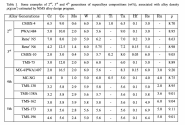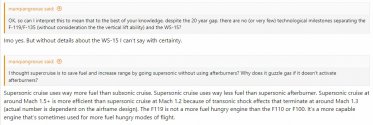Engine efficiency and capability in both power and weight parameters are driven first and foremost by the compressor cycle design. This was the key parameter driving improvement from third gen to fourth gen and fourth gen to fifth gen engine designs. A more powerful compressor for fewer stages means an engine that’s both lighter and also capable of a much greater energy budget to allocate to either thrust or fuel efficiency.What are the benefits of a counter-rotating engine? Is it really equivalent in complexity to VCE because I imagine it would be something like Gen 5.5 while VCE is Gen 6.
Technically since 4th gen all engines have been counter-rotating. It’s just a question of which stages of the engine are rotating in opposite directions. In 4th gens it was just the fan section relative to the LPC and HPC. In 5th Gen it was the fan and LPC relative to the HPC. The candidate for China’s 6th gen we are discussing makes individual alternating HPC stages themselves counter-rotating.
The reason counter-rotating engine cycles have been the key driver of performance comes down to how gas turbines work. Gas turbines compress air from the front of the engine, drives the compressed air into a burner, ignites it with fuel to release combustion energy, and expels it through the back of the engine. A turbine positioned behind the burner meanwhile collects some of the energy released to rotate the compressors to keep the engine going. To get more thrust you need to compress more air. Compressing air harder lets you expel air with more force and also makes the air-fuel burn more efficient leading to more extraction of energy, and thus work and force from the air-fuel mix. You can compress more air by spinning the compressors faster and by adding more compression stages. Adding more compression stages makes your engine longer and heavier though so this isn’t a scalable solution. Spinning the compressor faster eventually hits a mechanical limit for the rotors and axles driving the engine cycle. Counter-rotating designs get around the rotation speed limits by introducing a second axle that spins in the opposite direction. Two rotors spinning in opposite directions doubles the angular velocity of the compressors working on the air stream without doubling the single axle rotation speed or adding more stages. Put more alternating stages in counter-rotation to one another and you get more compression at each stage, which means you can extract more power while also reducing the number of stages.
The 4 stage counter-rotating HPC turbine cycle China has been working on for their 6th generation fighter moves further in this direction than what 5th Gen designs do, where the primary counter-rotating components are the LPC section and the HPC section. China’s 4 stage counter-rotating HPC has alternating HPC stages. For reference 5th gen engines like the F119, EJ200, and the WS-15 have 5-6 stage HPCs (we don’t actually know how many stages the WS-15 HPC has but all prior information on the engine suggests it’s 6). 4th gen engines meanwhile like the F100, F110, Al-31, and WS-10 have 9-10 stage high pressure compressors.
VCEs have their own set of mechanical complexities. VCE design primarily involves introducing some means of varying the effective bypass ratio of the front section of the engine, either with multiple front fans that run for different parts of the flight regime, by varying the geometry of the bypass stream that the fan drives around the core (turbofans split the stream of air it sucks in into a bypass stream that is purely driven by the fans without further compression pushed to the exit of the engine and a main stream that goes into the compressors to drive the turbine cycle), by adding additional stream paths into the engine’s architecture, or some mix of all three.
These are both mechanically complex approaches to driving higher engine performance, but in my estimation bringing counter-rotating cycles to alternating HPC stages is actually in some ways more complex than VCE design. But FWIW these are not also mutually exclusive design approaches either. You can combine the two, though it’s an open question whether you’d want to tackle the challenges of doing both together for a next generation engine.
Last edited:


